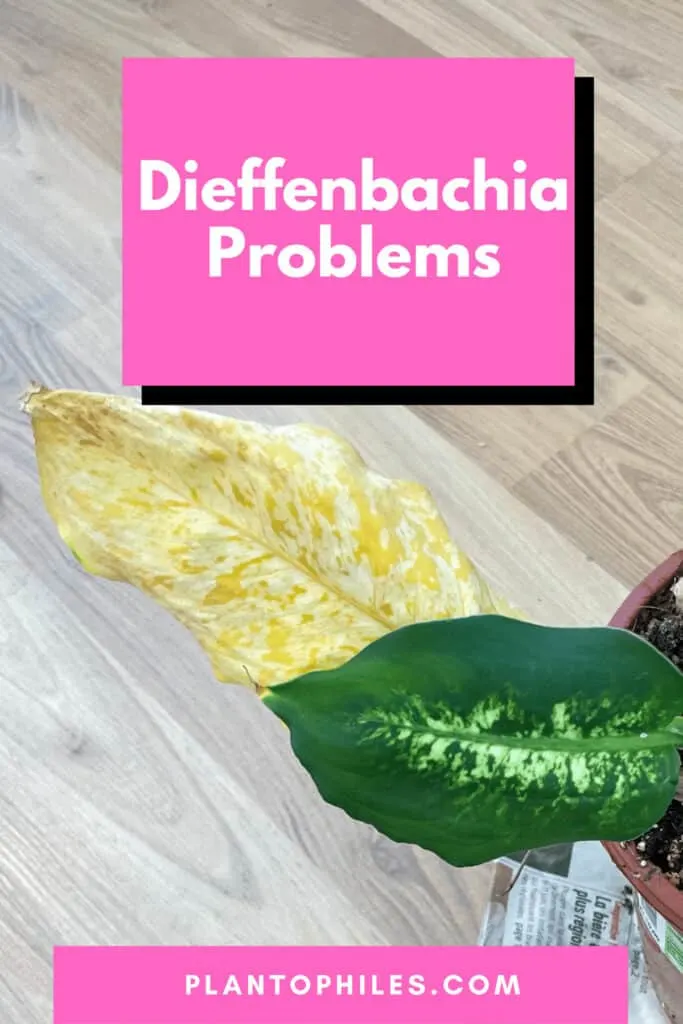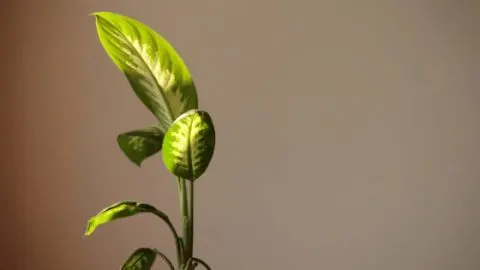You are reading this article to learn about Dieffenbachia problems, their causes, and their remedies.
Table of Contents
6 Common Dieffenbachia Problems
Dieffenbachia a common houseplant. It is an easy-to-care-for plant that is very expressive when something is amiss with its care routine. This is why you may come to the point where you have to ask yourself, “Why is my Dieffenbachia dying?”.
A common complaint about Dieffenbachia’s is that their leaves turn yellow.
This is the first sign of Dieffenbachia’s unwell; its leaves turn yellow and fall off. It is usually easy to figure out what is wrong with the care and change it before the plant dies.

Takeaways
These are the most common Dumb cane problems.
| Dieffenbachia Problems | Causes | Remedies |
|---|---|---|
| 1. Dieffenbachia Watering Schedule | Over or underwatering |
- Let soil dry slightly between waterings. - Avoid soaking the roots. - Repot if in a too-large pot. - Ensure well-draining soil with perlite. |
| 2. Too Much Sunlight | Excessive sunlight |
- Move plant away from direct sunlight. - Provide indirect light. |
| 3. Low Temperature Stress | Low temperatures (below 55°F / 13°C) |
- Maintain temperature 65-75°F / 18-24°C. - Protect from drafts. |
| 4. Nutrient Deficiencies | Lack of proper nutrients |
- Plant in nutrient-rich soil mix. - Use complete fertilizer during growing season. - Avoid prolonged nutrient deficiency. |
| 5. Root System Issues | Root-bound plant |
- Repot into a slightly larger pot if root-bound. - Avoid excessive pot size increase. |
| 6. Pest Infestations | Mites or aphids |
- Use insecticidal soap or Neem oil on leaves. - Remove pests with rubbing alcohol. |
1. Dieffenbachia Watering Schedule
The leaves of a dieffenbachia will turn yellow, and the plant will get distressed if it is over or underwatered. If the soil is very wet, let it dry out slightly until it is dry at the top.
The roots can get soaked and drown, causing the plant to get stressed and die. The soil should be dry to the first knuckle before watering. If it is any drier, the leaves will turn yellow and then brown, and the plant will ultimately die from underwatering.
Sometimes if the plant is in a pot that is too large for the root system, it will suffer. The plant should have no more than 2 inches around and beneath the root system. Otherwise, the soil will not dry enough in between watering. This causes the roots to stay wet for too long and get root rot.
If you overwater, let the root system dry out by waiting 7 to 10 days between watering. Make sure the plant is repotted into a proper pot if the pot is too large for the roots, and remove all yellowing or dying leaves from the plant. This should bring the plant back to a healthy state.
It is also beneficial to ensure your Dieffenbachia is planted in well-draining soil with perlite. The better the roots drain, the more chance the plant will remain healthy.
2. Too Much Sunlight For the Dumb Cane
Dieffenbachias thrive in partially shady conditions but can experience stress in bright areas. Sometimes if a dieffenbachia is in bright or direct sunlight, it will droop and ultimately die.
It is used to being in the shady jungle ground, which is not too hot and bright. Bright sunlight can scorch the leaves and cause death.
If you suspect sunlight is the culprit to your dieffenbachia being unwell and turning yellow, put it back from the window so that all the light it receives is indirect. It needs some sunlight but never directly onto its leaves.
3. Low Temperature Causes Stress to the Dieffenbachia Plant
Dieffenbachias should be kept at 65 to 75 degrees Fahrenheit (18-24 degrees Celsius). If the temperature gets too much lower than that consistently, your plant will droop and eventually die.
If the leaves don’t turn yellow before they droop, it is a sign that the plant is too cold. Don’t allow the room your Dieffenbachia is in to get cooler than 55 degrees (13 degrees Celsius).
A drafty area can also affect Dieffenbachia. Make sure the plant is away from draftiness in your home. The temperatures need to be warm and consistent.
I keep mine away from my air conditioner vents in the summer and closer to the indirect sunlight in the winter to ensure it stays at its optimal temperature.
4. Nutrient Deficiencies in Dieffenbachias
If a dieffenbachia doesn’t get the proper nutrients, it can cause yellowing of the leaves. In extreme cases, it can die if the plant is nutrient deficient for too long.
The cause for this can be that the soil it is in is not nutrient-rich enough for a Dieffenbachia. Dieffenbachias thrive in pure peat moss or a 1:1 peat moss and perlite mix.
They can also do well in a 1:1:1 peat moss, perlite, and soil mix, but I would never plant a Dieffenbachia in pure soil with no peat moss.
I prefer a mix that has perlite in it as well. I find that this is the optimal mix for a nutrient-rich plant.
I also make sure to give my dieffenbachia a complete fertilizer, such as 20-20-20, every 4 to 6 weeks during its growing season. I give it food much less in the dormant times, usually every 8 to 10 weeks.
5. Root System Issues
Dieffenbachias are prone to being root-bound. They have an extensive root system, and the plant suffers when they get too tightly wound.
You can tell if the plant is getting too root-bound by looking at the watering holes in the pot. If the roots come out of the holes, the plant is root-bound.
Transfer it to a larger pot but not more than 1 to 2 inches bigger (2.5-5 cm) than the root ball, which can also cause problems for the plant’s health.
6. Pest Infestations on a Diffenbachia Plant
Pests can be a problem with most indoor plants. The most common infestations for Dieffenbachias are mites or aphids.
Check under the yellow leaves for webby material for a spider mite infestation, and aphids can be seen crawling all over the leaves.
To solve a pest problem, you can use insecticidal soap on the leaves, or Neem oil can be wiped with a cotton ball to suffocate the pests. I have also used rubbing alcohol successfully on a spider mite infestation.
Conclusion
There are several reasons why your Dieffenbachia could be dying or turning yellow. Usually, it is easy to fix the culprit of the yellow leaves, but once the leaves have started to turn, it is only a matter of time before the whole plant turns yellow and dies.
Gently pull the yellow leaves off or snip them with clean and disinfected shears so they don’t infect the others.
Most often, yellow leaves are an issue with the watering schedule or temperature, so those are the two things I would try and fix first.
Dieffenbachias can live a very long and happy life if you keep these six common mistakes in check. I hope this Dieffenbachia problems guide was helpful.

Daniel has been a plant enthusiast for over 20 years. He owns hundreds of houseplants and prepares for the chili growing seasons yearly with great anticipation. His favorite plants are plant species in the Araceae family, such as Monstera, Philodendron, and Anthurium. He also loves gardening and is growing hot peppers, tomatoes, and many more vegetables.


